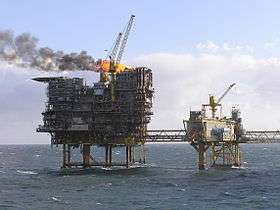Tyra Field
| Tyra Field | |
|---|---|
 Platform at Tyra East | |
| Country | Denmark |
| Region | North Sea |
| Block |
5504/11 5504/12 |
| Offshore/onshore | offshore |
| Operator | Maersk Oil |
| Partners |
Maersk Oil Royal Dutch Shell Chevron Corporation |
| Field history | |
| Discovery | 1968 |
| Start of production | 1984 |
| Production | |
| Current production of gas | 237.8×106 cu ft/d (6.73×106 m3/d) |
| Estimated gas in place | 1,250×109 cu ft (35×109 m3) |
| Producing formations | Danian and Upper Cretaceous Chalk |
Tyra Field is the largest gas condensate field in the Danish Sector of the North Sea.[1] It was discovered in 1968 and production started in 1984.[2] The field is owned by Dansk Undergrunds Consortium, a partnership between Maersk Oil, Royal Dutch Shell and Chevron Corporation, and operated by Maersk Oil.[3]
Description
The total proven reserves of the Tyra gas field are around 1,250 billion cubic feet (35×109 m3), and production is centered on 237.8 million cubic feet per day (6.73×106 m3/d).[4] The reservoir depth is about 2,000 metres (6,600 ft) and it covers area of 90 kilometres (56 mi) in the water depth of 37–40 metres (121–131 ft).[2]
Facilities
The Tyra Field has two production complexes named Tyra West and Tyra East, connected by pipelines. Tyra West includes oil and gas processing plants which in addition to the gas produced at the Tyra field, processes also gas from Halfdan and Valdemar fields. The complex consists of two wellhead platforms, one processing and accommodation platform, and one gas flare stack. Tyra East processes also oil and gas from Valdemar, Roar, Svend, Tyra Southeast, Harald, Lulita, Gorm and Dan fields. It consists of two wellhead platforms, one processing and accommodation platform, one gas flare stack, and one riser platform.[2]
In total, the field has 20 gas-producing wells, and 28 oil and gas-producing wells.[2]
Produced oil is transported to the Gorm E riser platform in the Gorm field, and further through the subsea pipeline to the oil terminal in Fredericia, Denmark. Produced natural gas is transported from the Tyra East riser platform to Nybro Gas Processing Plant, Denmark, and from Tyra West riser platform to the Netherlands through the Tyra West – F3 and NOGAT pipelines.[3]
References
- ↑ Glennie, K. W. (1998). Petroleum geology of the North Sea: basic concepts and recent advances. Wiley-Blackwell. p. 343. ISBN 978-0-632-03845-9.
- 1 2 3 4 "Oil and Gas Production in Denmark 07. Appendix B: Producing Fields". Danish Energy Agency. Retrieved 2011-01-15.
- 1 2 International Energy Agency (2006). Energy policies of IEA countries: Denmark 2006 review (PDF). OECD. p. 146. ISBN 978-92-64-10971-1.
- ↑ Hahn-Pedersen, Morten (1999). A.P. Møller and the Danish oil. Schultz Forlag. ISBN 978-87-609-0465-3.